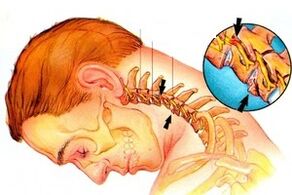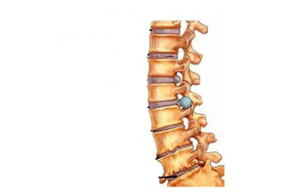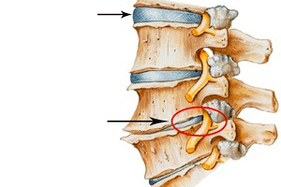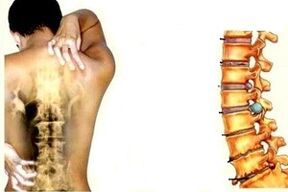
Diseases of the musculoskeletal system are one of the most common diseases in the soil.Few people manage to avoid them completely, especially after 40 years, though experts admit that problems with the spine, muscles and joints have "younger", and many young people are increasingly complaining about pain.
The fault of this is the way of life, which is already known to many people: inactivity, prolonged stay in one position (more often behind tools and monitors), lack of physical activity.As a result, the posture is disturbed, salts and other harmful substances accumulate in the body, the functions of the skeletal muscle system are damaged, and as a result, the internal organs can be deformed.
Most often, osteochondrosis is detected by such diseases, which people undergo both older and younger age, and among problems of osteochondrosis with lumbosacral spine and cervical spine.The second most frequency type of osteochondrosis, cervix, is an unpleasant, and in addition - progressive, without treatment, a deteriorating lifestyle to disability.This means that it is necessary to recognize the symptoms of this disease in a timely manner and in time to contact an orthopedic or a vertebologist for treatment.
How the cervical osteochondrosis develops
If a person runs a sedentary lifestyle or, due to his or her profession, is in the same position for a long time, then the risk of meeting osteochondrosis is very high.With the development of the disease, changes occur in intervertebral discs, they deform and change their structure.
The intervertebral discs are located between the beads, their task is to preserve the spine, make it flexible and stable.There are seven beads on the neck, with the help of which the head rests and rotates, the neck and so on is bending.The cervical vertebrae are located very close to one another, so they are injured and shifted from minor physical exercises.The risk of the disease lies in the fact that the nerve endings of the spinal nerve are affected, due to which vessels that supply the brain are affected.On the other hand, the brain does not receive vital substances, and this can lead to the development of a number of other, more serious diseases that can cause disability and even the patient's death.
There are many causes and development of cervical osteochondrosis.Among the most common and most common reasons, the following can be distinguished:

- Damaged metabolism in the body, in particular, in the cervical region, hormone imbalance;
- Salt deposition;
- low physical activity, sedentary lifestyle;
- long stay in a position (on the computer, car wheel, etc.);
- Improper food;
- Excess weight;
- Injuries and neck bruises;
- Hypothermia of the body.
Osteochondrosis also occurs against the backdrop of chronic diseases of the muscular system, such as scoliosis or rheumatism.
In addition, an osteochondrosis often leads to a genetic predisposition of the body.
But whatever the causes, osteochondrosis should be treated as soon as its first symptoms appear.
Signs of cervical osteochondrosis
Osteochondrosis in this spine does not always arise significantly and suddenly.Most often, it develops slowly, and the symptoms intensify over time, their number increases.The more damaged the beads and nerve roots are damaged, the more obvious the signs are.
The first symptom to be paid is the pain of different strength in the cervical back, which gives other parts of the body - the back of the head, forehead, ears, forearm, shoulder, chest, etc.In case of pain, consult a doctor to determine if it is really osteochondrosis, which is often similar in symptoms with other diseases.
Other signs of osteochondrosis
- Neck pain is improved by loads or curves of the head;
- The patient feels numbness, burning or tingling in the limbs;
- Headache and dizziness, a breakdown, the patient may complain of darkening and flies in his eyes, noise in his ears;
- With a sharp twist of the head, the pallor is likely.
Osteochondrosis is also characteristic of cervical osteochondrosis:
- violation of coordination;
- heart pain;
- Deterioration of vision and hearing.
Varieties of osteochondrosis
Depending on the type of nerve tip and the nature of the development of the disease, doctors distinguish several syndromes:
- Spine syndrome;
- Vertebral artery syndrome;
- Cardial syndrome.
Root syndrome is a top of the first pairs of cervical nerve endings.The pains feel in the neck, they are given in a shoulder blade, the lower back, shoulder, forearm.
With vertebral artery syndrome, the patient experiences a pulsating pain in the back of the head or temples or burning pain in the neck, the back of the head, which increases the head, during sleep, coughing, gives that chest, shoulder.
With cardiac syndrome, the symptoms first resemble pectoris angina, but the pain does not pass after taking nitroglycerin lasts for several hours and can intensify when moving and deep breathing.
Symptoms of damage to specific vertebrae
The treatment of osteochondrosis is prescribed on the basis of which the nerve ending was damaged.There are only eight of them, each of which is above the cervical vertebra.It is possible to determine which of the vertebrae is struck by symptoms corresponding to a certain nervous spine.
Damage to nerve endings and characteristic pain

- First and second departments: the sensitivity of the back of the head, the pain in the parietal and occipital region is broken;
- Third Department: neck numbers in the field of pinching, damage to speech, language sensitivity;It rarely happens;
- Fourth Department: pain and numbness in kolarbon and/or spatula, respiratory system violations, heart pain;
- Fifth section: shoulder pain, pain on the outer surface of the shoulder, damaged limb sensitivity;
- Sixth and seventh departments: neck pain, blade, forearm, spine, spine, damaged sensitivity of hands, fingers;The most common loss;
- Eighth Department: neck pain, spine, elbow, numbness of small fingers of all limbs, blue and brushes due to circulatory disorders, lack of skin sensitivity and gives to feet.
Diagnosis and treatment of cervical osteochondrosis

To make sure the diagnosis of "cervical osteochondrosis", you should definitely consult a doctor.Many symptoms of osteochondrosis are similar to the signs of other diseases, so it is important not only in time to start the treatment of osteochondrosis, but also not to lose another pathology.
In case of doubt of osteochondrosis and pinching signs of nerve endings, the doctor prescribes radiography, with resonance tomography consisting of data failure or magnetic resonance tomography, additional ultrasonic dopplerography and double scan.
Based on these studies, the nature of the pain syndrome and the totality of other symptoms, you can determine which discs are damaged, and begin the necessary treatment, which will restore the affected beads and nerve roots and will not allow the complications of osteochondrosis to develop.
The treatment is prescribed by the doctor, it is usually complex.First of all, it should relieve the symptoms of pain, which, with cervical osteochondrosis, are sometimes virtually unbearable and spread not only to the neck but also to other parts of the body.
To do this, use soothing soothing in the tablets, but in the case of extremely severe pain, non -steroidal anti -inflammatory drugs are shown, as well as heat painkillers and painkillers.
Since medicines and ointments relieve only pain and other symptoms of neck osteochondrosis but do not escape its cause.Once painful sensations are reduced, the patient is prescribed massages, physiotherapy and physiotherapy.The patient indicates a diet, medicines that improve blood circulation and support body functions, tablets and injections, as well as chondroprotectors that help protect and restore intervertebral discs.
In some cases, baths, paraffin applications, reflexology, hiruterape are described as additional treatment for the patient.Popular methods of treating cervical osteochondrosis often helps quickly to turn the patient into ordinary lifestyle, but they should only be used in combination with traditional methods and after advising a physician, as traditional medicine may have contraindications, and the use of its recipes can damage the body so weakened by the body.
Complications and prevention of the disease

Remember: treatment for cervical osteochondrosis should be started as soon as possible.The longer you draw a visit to the doctor, the harder it will be to cure the disease, and in the meantime can cause different complications.The cervical spine osteochondrosis is very dangerous in the fact that there are many blood vessels and nerve plexuses that feed the brain in this part.
Anydo violation can cause problems with brain circulation, neurological disorders, including migraine and hypertension, affect the heart, respiratory system, hearing, vision.
If osteochondrosis is initiated, more serious consequences are possible in the form of brain ischemia, spinal cord or radiculopathy - a disease in which processes in the affected beads are formed, partially or completely depriving the body of sensitivity and movement.But this is not the worst thing, as in severe osteochondrosis, the spinal cord is compressed, which can cause the patient's death.
Therefore, it is very important to listen to the symptoms as soon as possible and turn to a specialist who will help you return to a full life.And to avoid a disease such as cervical osteochondrosis, you need to move more, not avoid physical activity, monitor weight, eat properly and in a balanced, and also visit an orthopedist or vertebologist regularly.

























